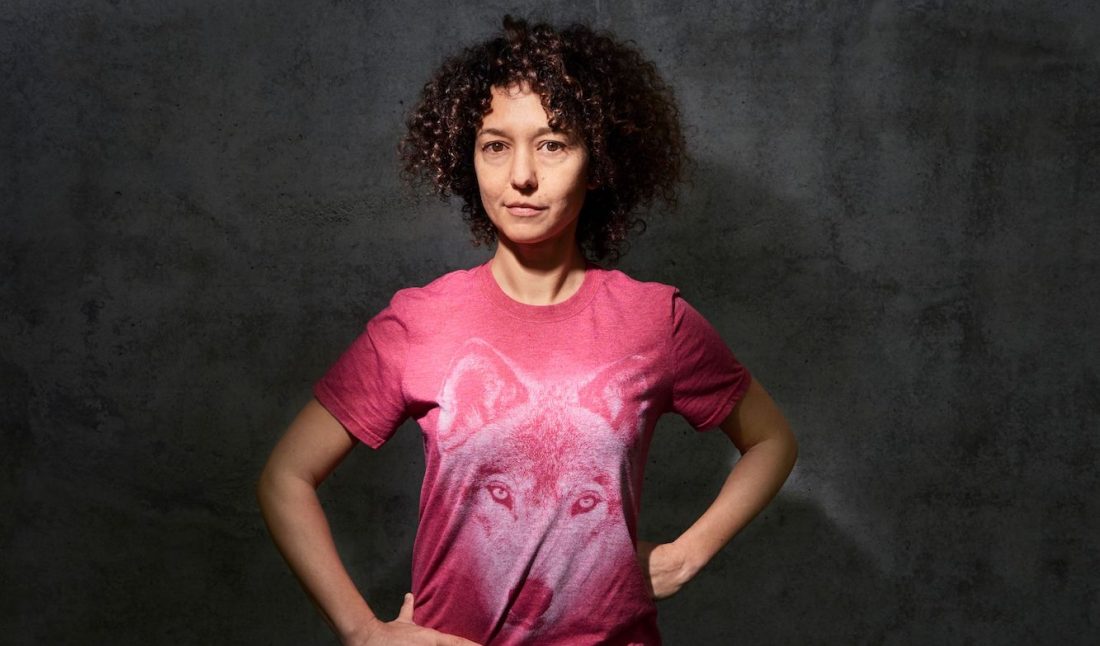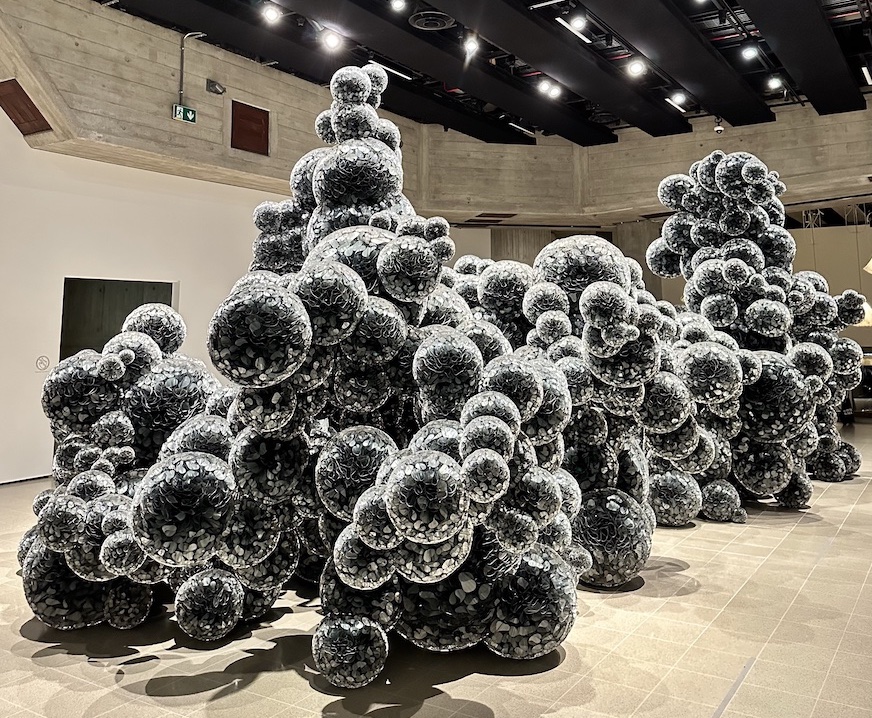Now on view in Los Angeles is Mika Rottenberg’s first major exhibition on the west coast. At Hauser & Wirth through October 2, the dynamic presentation features acclaimed video works, such as Spaghetti Blockchain (2019), Cosmic Generator (2017), and NoNoseKnows (2015), in addition to new kinetic sculptures, drawings, and installations. The artist also celebrates the upcoming global release of Remote, her first feature film premiering in late September, made in collaboration with filmmaker Mahyad Tousi. The piece was created during the Covid-19 pandemic, and is set in a post-pandemic near future. Five women living in different parts of the world, all of them fans of a popular South Korean dog-groomer-performer, discover a mysterious portal hidden in each of their homes with universe-altering consequences.
Born in Buenos Aires, Rottenberg spent her formative years in Israel, then moved to the United States. She earned her BA from the School of Visual Arts in New York, followed by an MFA at Columbia. Rottenberg was the recipient of the 2019 Kurt Schwitters Prize, which recognizes artists who have made a significant contribution to the field of contemporary art. In 2018, she was the winner of the Smithsonian American Art Museum’s James Dicke Contemporary Artist Prize, which recognizes an artist younger than 50 who has produced a significant body of work and consistently demonstrates exceptional creativity.
 Mika Rottenberg, “Spaghetti Blockchain” (Video Still), 2019, Single-channel 4k video installation, 7.1 surround sound, color; 18:15 min; © Mika Rottenberg, courtesy of the artist and Hauser & Wirth.
Mika Rottenberg, “Spaghetti Blockchain” (Video Still), 2019, Single-channel 4k video installation, 7.1 surround sound, color; 18:15 min; © Mika Rottenberg, courtesy of the artist and Hauser & Wirth.
Throughout her utterly inventive works, the artist explores the absurdity of humanity’s rampant production, distribution, and consumption of objects by juxtaposing existing industry with her own unique manufacturing systems. Rottenberg expands, “I think of objects in terms of the processes behind them and the idea that humankind is captured in everything around us. I want to make these processes more visual. If art has any power, it is in making things visible.”
The exhibition showcases the magnitude and rigor of Rottenberg’s compelling practice. Spaghetti Blockchain examines how humans manipulate and comprise matter, and their relationship with the mechanical world. Titled after blockchain technology, this work merges images and sounds to create fast-shifting connections between a diverse range of sources that weave into themselves with no resolution. The film features a Tuvan throat singer, whose voice reverberates across the Siberian prairie. The deep drone of her voice is juxtaposed with highly technical imagery and low electronic hums, giving way to a plethora of interpretations.
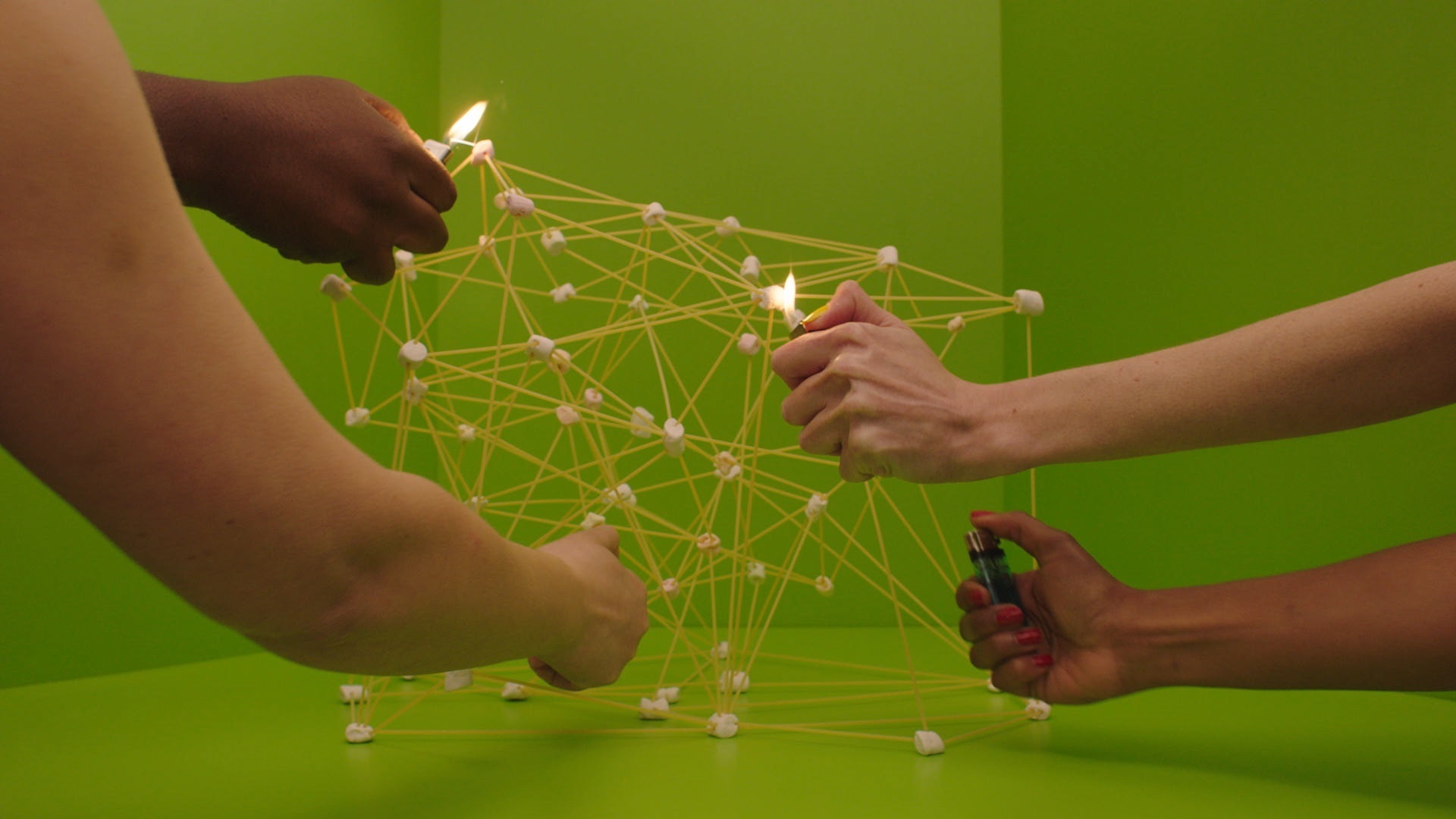 Mika Rottenberg, “Spaghetti Blockchain” (Video Still), 2019, Single-channel 4k video installation, 7.1 surround sound, color; 18:15 min; © Mika Rottenberg, courtesy of the artist and Hauser & Wirth.
Mika Rottenberg, “Spaghetti Blockchain” (Video Still), 2019, Single-channel 4k video installation, 7.1 surround sound, color; 18:15 min; © Mika Rottenberg, courtesy of the artist and Hauser & Wirth.
Cosmic Generator looks at the concept that material is not static but is in constant transformation, while humans are confined to the banal reshaping of material as a result of global capitalism. Filmed on site in Yiwu, China and at the border between Mexicali, Mexico and Calexico, California, the video installation forms connections among seemingly disparate geographies. In Yiwu, women sit amongst thousands of colorful plastic objects. They yawn, and scroll their phones, confined to a sea of plastic junk to be distributed across the world. On the border of Mexicali and Calexico, home to a large Chinese population, a Prohibition-era tunnel system subverts the border above it, which bars humans from crossing, while objects from the Chinese warehouse move without restriction.
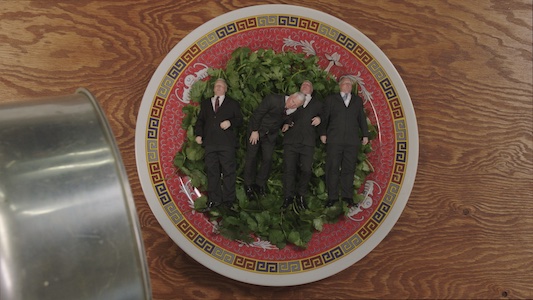 Mika Rottenberg, “Cosmic Generator” (Video Still), 2017, Single-channel video installation, sound, color, 26:36 min; © Mika Rottenberg, courtesy of the artist and Hauser & Wirth.
Mika Rottenberg, “Cosmic Generator” (Video Still), 2017, Single-channel video installation, sound, color, 26:36 min; © Mika Rottenberg, courtesy of the artist and Hauser & Wirth.
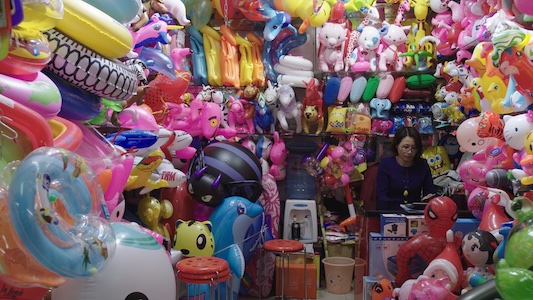 Mika Rottenberg, “Cosmic Generator” (Video Still), 2017, Single-channel video installation, sound, color, 26:36 min; © Mika Rottenberg, courtesy of the artist and Hauser & Wirth.
Mika Rottenberg, “Cosmic Generator” (Video Still), 2017, Single-channel video installation, sound, color, 26:36 min; © Mika Rottenberg, courtesy of the artist and Hauser & Wirth.
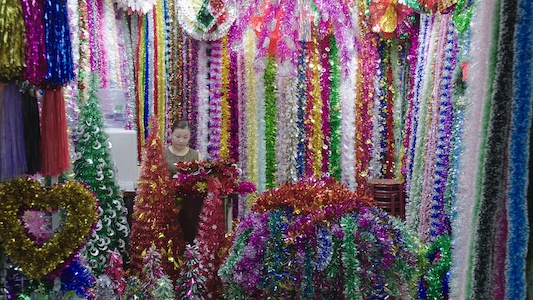 Mika Rottenberg, “Cosmic Generator” (Video Still), 2017, Single-channel video installation, sound, color, 26:36 min; © Mika Rottenberg, courtesy of the artist and Hauser & Wirth.
Mika Rottenberg, “Cosmic Generator” (Video Still), 2017, Single-channel video installation, sound, color, 26:36 min; © Mika Rottenberg, courtesy of the artist and Hauser & Wirth.
Shown to critical acclaim at the 2015 Venice Biennale, NoNoseKnows transports the viewer between an anonymous office suite in New York and an enormous pearl-making facility in Zhuji, China. In one, an extremely tall woman with an exaggeratedly long nose sits alone in a claustrophobic office surrounded by colorful bouquets of flowers. Every time she sniffs them with her visibly irritated nose, an allergic reaction triggers a sneeze that produces a plate of noodles. In the other, a row of women factory workers seated at a table pry open mussels and insert sinuous foreign matter with tweezers which over time will aggravate the creature, producing a pearl. The surgical precision through which the factory workers cultivate the pearls mirrors the shrewd editing techniques of the video work; thus the intricacies of labor and the production of value are rendered visible.
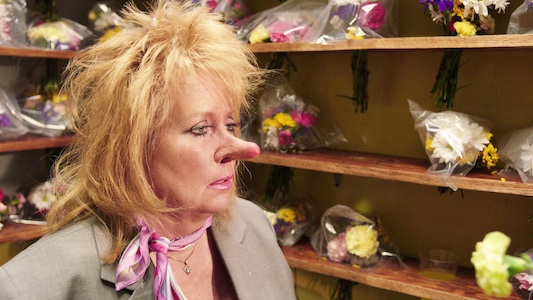 Mika Rottenberg, “NoNoseKnows” (Video Still), 2015, Single-channel video installation, sound, color, 21:58 min; © Mika Rottenberg, courtesy of the artist and Hauser & Wirth.
Mika Rottenberg, “NoNoseKnows” (Video Still), 2015, Single-channel video installation, sound, color, 21:58 min; © Mika Rottenberg, courtesy of the artist and Hauser & Wirth.
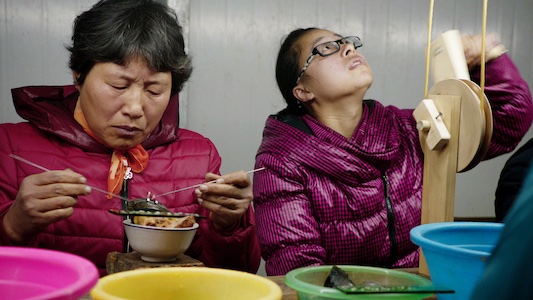 Mika Rottenberg, “NoNoseKnows” (Video Still), 2015 Single-channel video installation, sound, color, 21:58 min; © Mika Rottenberg, courtesy of the artist and Hauser & Wirth.
Mika Rottenberg, “NoNoseKnows” (Video Still), 2015 Single-channel video installation, sound, color, 21:58 min; © Mika Rottenberg, courtesy of the artist and Hauser & Wirth.
The current show includes a selection of drawings created over the course of the pandemic. Couplings of fingerprints, human limbs, and palm trees exponentially reproduce and ultimately vanish, evoking diagrams of chain reactions and biological systems. A gestural application of graphite and paint coalesce, connecting the artist’s body to the work. For the artist, the body is its own kind of producer, which makes hair and nails, but also marks on a piece of paper. Rottenberg deftly explores larger themes such as labor and production in relation to the corporeal and the mechanical.
Reminiscent of Rube Goldberg machines, Rottenberg’s kinetic sculptures are composed from recycled materials and sculptural elements that are arranged into machines. In some of the sculptures, human labor is necessary to activate motion—arms turn cranks and legs pedal wheels. A new group of sculptures are powered by electricity, exploring the overlapping functions of humans and machines. Rottenberg explores the physical and metaphorical distance between human labor and mechanical production. The artist states,: “I think in my work I try to give shape to the way things are made and consumed, which has become so vast as to become unimaginable. If we actually comprehended the insanity of it, I think people would probably behave differently.”
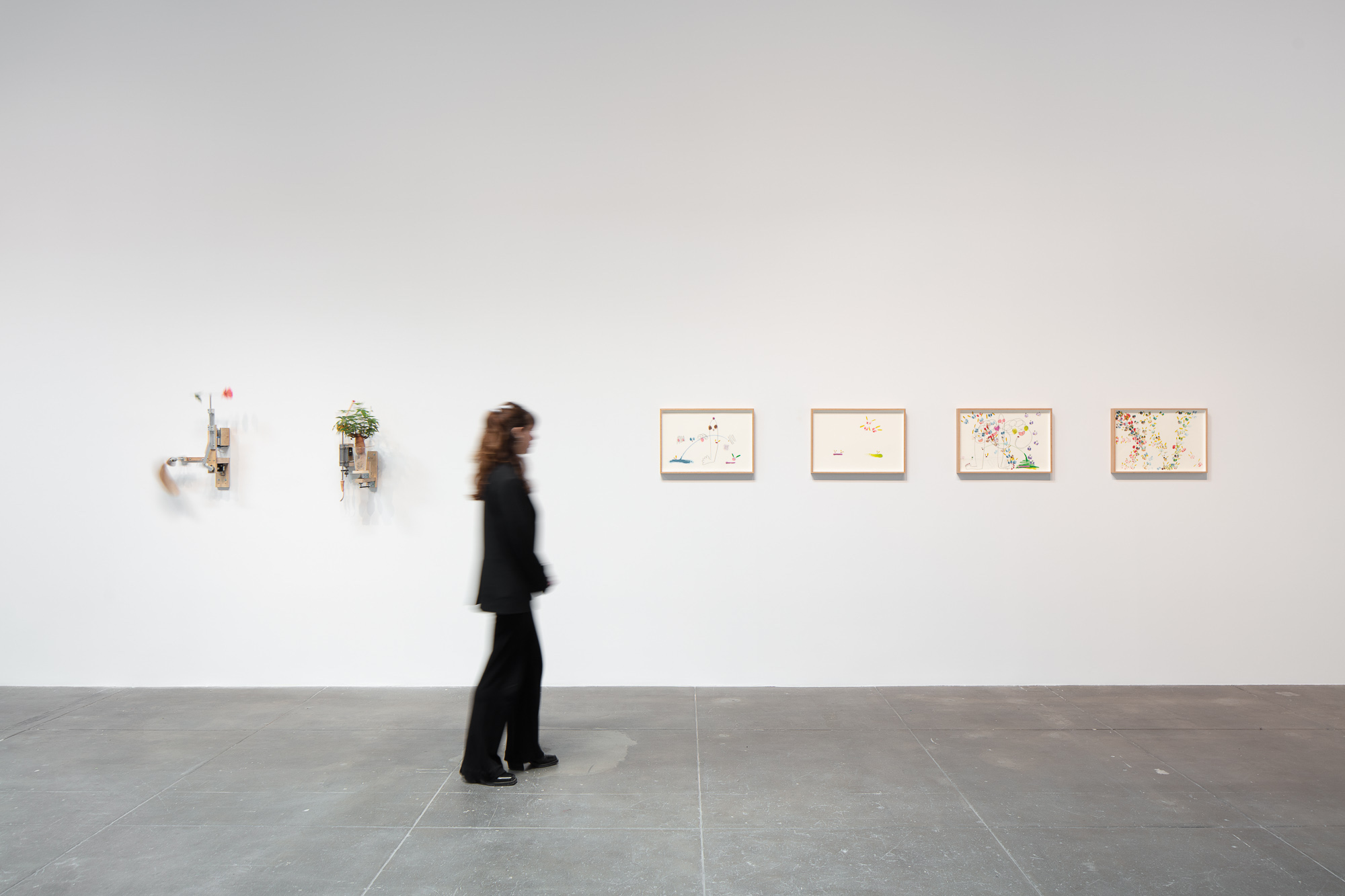 Installation view of Mika Rottenberg at Hauser & Wirth, Los Angeles, photo by Zak Kelley, courtesy of Courtesy the artist and Hauser & Wirth.
Installation view of Mika Rottenberg at Hauser & Wirth, Los Angeles, photo by Zak Kelley, courtesy of Courtesy the artist and Hauser & Wirth.






